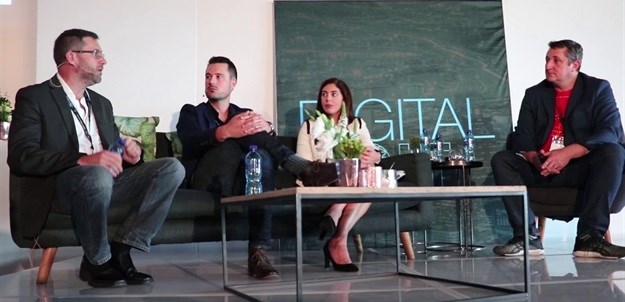
Subscribe & Follow
Jobs
- Head of Digital Johannesburg
- Social Media Specialist Johannesburg
- Digital Brand and Marketing Manager Cape Town
- Digital Projects Administrator Pretoria
- Mid-level SEO Specialist Cape Town
- Digital AI Intern Cape Town
- Paid Media Specialist Cape Town
- Video Editor Cape Town
- Content Creation Lead Cape Town
- Copywriter Cape Town
The future of media

Since the beginning of advertising, marketers have tried to create brand resonance, then turn it into sales by telling a story, by telling their potential customers what they thought they needed to hear in a place where they hoped they’d be paying attention. This hasn’t changed much. We still strive to keep our messaging relevant and deliver it in a place where our audience will engage – except now the simplicity of delivering the message once had, is much more complex. The simplicity we used to have in setting up the message for delivery and controlling the delivery thereof no longer exists in today’s media landscape. Not only do we have many more platforms, we have hundreds more modes of delivery and we are competing for local audiences in massive global arenas.
But as they say… when you are up to your bum in crocodiles, it’s hard to remember your original intention was to drain the swamp. The trick is to keep remembering what our original intention is. So how do we do that? We use the astounding technologies that we, as marketers, have at our fingertips today to assist us through “this swamp.”
Mobile
Early adoption mobile marketers, less fearful of exploring new avenues, or maybe less fearful of letting go of historic “mainstream” media platforms, are leading the pack and are undoubtedly owning the first mover to market advantage. A good example here is the News24 app. 24.com were first to market with a digital news app and as a result News24 completely dominates the numbers when it comes to users. Currently this app has nearly 4x the unique browsers and 9x the page views than all its local competitors combined. Which means not only is it a much larger audience, it is also attracting repeated usage, higher frequency and more brand trust.
News24 have expanded their mobile offering to include the app Edge, which was recently voted best app in the world. This app has mastered the art of delivering a personalised news experience using machine learning. In a nutshell, as Edge users interact with the app they generate signals (digital footprints if you will). The data scientists at 24.com collect millions of these signals and this raw data (big data at its best) is processed into user behaviour models which form the basis of the app’s algorithms. It sounds a lot simpler than it is – it gets complicated when we remember that people consume content based on the time, the day, their location or big news stories. The learning is ongoing and the models keep improving, which is at the core of machine learning (ML).
Many marketers have and are adopting a ‘wait and see’ attitude when it comes to mobile, digital and innovative technologies – not sure how to navigate the barrage of service and technology providers all promising to be the answer, the silver bullet, the magical solution to all the anxiety – the lifeboat in the swamp. But businesses can’t afford to be doing that anymore – particularly not with mobile in the South African market. Marketers in this country know that audiences have migrated to mobile – the message is coming through louder than ever – but cracking “the code” on how to maximise the value mobile could contribute, remains challenging.

We’re seeing mobile ad spend doubling up year on year but even at this rate, it still is not catching up with mobile consumption and audience growth. Important to note is that this is an irreversible trend – desktop won’t reclaim its original position as the king of online media consumption devices.
There’s a caveat to mobile though, it’s more than just a (traditional) advertising medium. It is also a storefront and a direct channel to market for marketers and that fundamentally changes the game. Budgets should not just be gearing towards supporting it as a media buy; they also need to support it as an e-commerce destination and direct marketing and customer communication channel. It’s easier to manage these demands if you’re a digital only business. However if you’re predominantly a brick-and-mortar business, the challenge to focus on all aspects of mobile whilst keeping the traditional business wheels oiled and running, is much greater.
Mobile is multi-dimensional. It is not a single dimension traditional media platform and that leads to complexity which takes time, money, skill and expertise to explore, understand and capitalise on. The easy approach is to over simplify it, opt for terrible ads at huge volumes, procured risk free. ‘Throw it against the wall and see what sticks. We’ll pay for what sticks.’ That could get you somewhere in the short-term, i.e. alleviate the pressure to get mobile active immediately, without really committing resources. But astute brands and astute marketers will realise that that is not a long-term strategy and it definitely will not equip their businesses to understand and maximise the benefits from engaging their consumers on mobile. Mobile can be the vehicle, the destination, or it can be both. It is a tool to fulfil on the greater strategy – but mobile, by itself, isn’t the strategy.
Data
While the essence of advertising remains the same (to present products in a way that connects sellers with buyers) the how-to-do-that-effectively has changed dramatically. We now need to harness real-time measurement and placement tools to ensure pinpoint accuracy. This means that data, analytics and optimisation aren’t just “nice to haves”, they are essential business tools. We see on our own data management platform that client campaigns utilising audience targeting and then retargeting against segments that interacted with the brand deliver a significantly higher return. The improved relevancy, avoided wastage and increased frequency make this a no-brainer for advertisers as it ensures advertisers maintain top of mind awareness and increases brand association amongst people most likely to convert.
The ability to reach pre-qualified audiences, at scale, in brand safe environments, utilising high impact and rich creative executions, with seamless technical integration into client’s systems and workflows enables us to play a far greater part in the complete digital media solution. Far beyond the one-dimensional approach, i.e. “over simplify it; opt for terrible ads at huge volumes, procured risk free.” In other words: ‘Throw it against the wall and see what sticks. We’ll pay for what sticks.’
So where to from here?
We are no doubt going to see a massive upsurge in the use of machine learning and artificial intelligence. It has been said that ML and AI will revolutionise our world more than the internet has.
When it comes to marketing, any task that requires the use of data and the marketer to interpret that data, will be affected by ML and AI. But I don’t think this is something we need to fear. The future of media is personalisation. We need to give our customers what they want, where they want it and how they want it – an experience that reflects their relationship with the brand. Through our investments in technology we now have the potential to do this with better results and less effort by embracing innovations. A win-win!




















